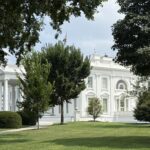Some believe that by skipping a summit of the Asia-Pacific Economic Cooperation Forum, American President Donald Trump may have given away the stage to China and its leader, President Xi Jinping.
But others would argue that for a person who shuns multilaterals, President Trump’s presence at the Association of Southeast Asian Nations meeting in Kuala Lumpur, his meetings with President Xi in Busan, Prime Minister Sanae Takaichi in Tokyo, and the President of South Korea, Lee Jae Muang, more than made up for it – showing American allies and adversaries alike that Asia mattered in Washington’s scheme of things in the Indo-Pacific. The meeting with North Korea’s strongman Kim Jong Un was actually a long shot—one that would not be tagged to President Trump for “not trying.”

The optics and atmospherics of President Trump in Asia could not have been better – over and beyond the American leader stepping up to the beats of traditional welcomes or apparently baffling Malaysian Prime Minister Anwar Ibrahim by asking him to come along for a ride in “The Beast.” Japanese Prime Minister Sanae Takaichi was seen visibly excited in the presence of her high-profile visitor from Washington – something not generally expected from a traditional society pegged to deep conservative and cultural norms.
The Asian countries President Trump visited literally rolled out the red carpet, showering praises and gifts, with Tokyo bestowing perhaps something the visitor wanted to hear: a nomination for next year’s Nobel Peace Prize – certainly from an established nation and an economic-cum-technology powerhouse in the international community.
President Trump’s three-nation visit to Asia went beyond the sentimentalism of receiving the putter used by his friend, the late Shinzo Abe, a gold golf ball, or a bag signed by Hideki Matsuyama, or receiving a replica of a historic Golden Crown of the ancient Korean kingdom of Silla. In substantive terms, the high point of President Trump’s trip was his meeting with his Chinese counterpart, Xi – a first face-to-face meeting in six years. It was not just Washington and Beijing that viewed the summit anxiously but the world at large, for the two countries appeared to be set on a trade collision course that would impact the international trading system globally.

“… Overall, I guess on the scale of 0–10, with 10 being the best, the meeting was a 12,” President Trump told reporters, adding, “I’ll be going to China in April, and he’ll be coming here sometime after that – whether it’s in Florida, Palm Beach, or Washington, D.C.”
One of the biggest bones of contention between the two economic giants was the supply of rare earths, over which the Chinese have a virtual monopoly and in which they had placed vigorous export controls – to which the Trump administration responded by announcing retaliatory tariffs of 100 percent on all Chinese goods. Now, President Trump has said that there is an agreement for a one-year deal on the supply of rare earths that could be renewed on an annual basis. Further, it has been announced that fentanyl-related tariffs levied on China would be reduced from 20 percent to 10 percent. Beijing has consistently maintained that slapping tariffs to halt fentanyl and other opioids will not solve the drug problem.
High on President Trump’s agenda were also Japan and South Korea, two of America’s staunch allies in East Asia but both receiving a lot of flak in recent months. Amid all the economic noise, there was also a realization that larger strategic issues could not be swept under the carpet or treated as any less important. Like the United States, Japan is quite aware of the need for crucial resources like rare earths and has been at the receiving end of Chinese shocks pegged to competing territorial claims. Hence, topping the agenda was a framework agreement on rare earths, with trade and investments also said to have featured quite prominently. As part of a deal agreed upon this September, Japan had pledged about US$500 billion by way of investments; but questions remain, at least from Japan’s perspective, about the nature of the spread, especially of the benefits.
There were significant readouts from President Trump’s meeting with South Korea’s President Lee Jae Muang, with approval for Seoul to build a nuclear-powered submarine touted as one of the highlights. The submarine will be built at the Philly Shipyard in Philadelphia, Pennsylvania. “Our military alliance is stronger than ever before, and based on that, I have given them approval to build a nuclear-powered submarine, rather than the old-fashioned and far less nimble diesel-powered submarines that they have now,” the President posted on his social media site.

And for a lower tariff rate, South Korea has agreed to pump in about US$350 billion into the United States; and President Trump has maintained that South Korea had also agreed to buy “vast quantities” of oil and gas that will push investments to exceed US$600 billion. Aside from putting auto tariffs on South Korea on par with those of Japan, it is believed that Korean Air will purchase 103 new Boeing aircraft.
At the end of the day, and from a longer-term perspective, traditional allies of America in Asia are looking at American commitment to a region increasingly threatened by a rising China, which is willing to flex its muscles in the South China Sea, especially against smaller countries like Vietnam and the Philippines, besides seeking “friendly” facilities in countries like Cambodia. But to China, it is perhaps bizarre to see nations calling for its adherence to international law when the West, along with its proxies, is busy dismantling an international order that, ironically, was of its own creation.
Disclaimer: The opinions and views expressed in this article/column are those of the author(s) and do not necessarily reflect the views or positions of South Asian Herald.






